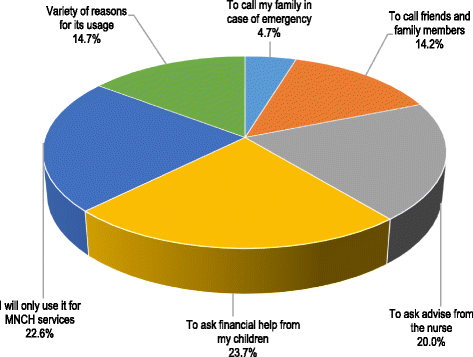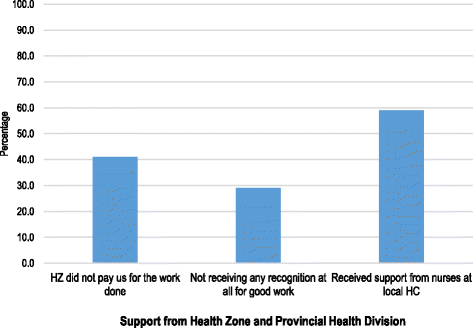Community-based maternal, newborn, and child health surveillance: perceptions and attitudes of local stakeholders towards using mobile phone by village health volunteers in the Kenge Health Zone, Democratic Republic of Congo
- PMID: 29506500
- PMCID: PMC5838964
- DOI: 10.1186/s12889-018-5186-2
Community-based maternal, newborn, and child health surveillance: perceptions and attitudes of local stakeholders towards using mobile phone by village health volunteers in the Kenge Health Zone, Democratic Republic of Congo
Abstract
Background: In early 2016, we implemented a community-based maternal, newborn, and child health (MNCH) surveillance using mobile phones to collect, analyze, and use data by village health volunteers (VHV) in Kenge Health Zone (KHZ), in the Democratic Republic of Congo (DRC). The objective of this study was to determine the perceptions of households, attitudes of community health volunteers, and opinions of nurses in Health center and administrative authorities towards the use of mobile phones for MNCH surveillance in the rural KHZ in the DRC.
Methods: We used mixed methods combining phenomenological and descriptive cross-sectional study. Between 3 and 24 March 2016, we collected the data through focus group discussions (FGD) with households, and structured interviews with VHV, local health and administrative authority, and nurses to explore the perceptions on MNCH surveillance using mobile phone. Data from the FGD and interviews were analyzed using thematic analysis techniques and descriptive statistics respectively.
Results: Health issues and services for under-five children were well known by community; however, beliefs and cultural norms contributed to the practices of seeking behavior for households. Mobile phones were perceived as devices that render quick services for people who needed help; and the community's attitudes towards the mobile phone use for collection of data, analysis, and use activities were good. Although some of community members did not see a direct linkage between this surveillance approach and health benefits, majority believed that there would be better MNCH services with the use of mobile phone. In addition, VHV will benefit from free healthcare for households and some material benefits and training. The best time to undertake these activities were in the afternoon with mother of the child, being the best respondent at the household.
Conclusion: Health issues and services for under-five children are well known and MNCH surveillance using mobile phone by VHV in which the mother can be involved as respondent is accepted.
Keywords: Community, perceptions, attitudes; Maternal, newborn, and child health surveillance; Mobile technology.
Conflict of interest statement
Ethics approval and consent to participate
The study protocol and all informed consent forms were approved by the World Health Organization Research Ethics Review Committee (WHO ERC) and University of Kinshasa’s Institutional Review Board (IRB). After agreeing to participate, all participants signed voluntarily the informed consents (in presence of witness for volunteers or households’ heads).
Consent for publication
Not applicable.
Competing interests
The authors declare that they have no competing interests.
Publisher’s Note
Springer Nature remains neutral with regard to jurisdictional claims in published maps and institutional affiliations.
Figures
Similar articles
-
Female respondent acceptance of computer-assisted personal interviewing (CAPI) for maternal, newborn and child health coverage surveys in rural Uganda.Int J Med Inform. 2017 Feb;98:41-46. doi: 10.1016/j.ijmedinf.2016.11.009. Epub 2016 Nov 28. Int J Med Inform. 2017. PMID: 28034411 Clinical Trial.
-
Cluster randomized trial of a mHealth intervention "ImTeCHO" to improve delivery of proven maternal, neonatal, and child care interventions through community-based Accredited Social Health Activists (ASHAs) by enhancing their motivation and strengthening supervision in tribal areas of Gujarat, India: study protocol for a randomized controlled trial.Trials. 2017 Jun 9;18(1):270. doi: 10.1186/s13063-017-1998-0. Trials. 2017. PMID: 28599674 Free PMC article. Clinical Trial.
-
Does mobile phone ownership predict better utilization of maternal and newborn health services? a cross-sectional study in Timor-Leste.BMC Pregnancy Childbirth. 2016 Jul 23;16(1):183. doi: 10.1186/s12884-016-0981-1. BMC Pregnancy Childbirth. 2016. PMID: 27448798 Free PMC article.
-
Use of mobile phones for behavior change communication to improve maternal, newborn and child health: a scoping review.J Glob Health. 2019 Dec;9(2):020425. doi: 10.7189/jogh.09.020425. J Glob Health. 2019. PMID: 31893032 Free PMC article.
-
Does women's mobile phone ownership matter for health? Evidence from 15 countries.BMJ Glob Health. 2020 May;5(5):e002524. doi: 10.1136/bmjgh-2020-002524. BMJ Glob Health. 2020. PMID: 32424014 Free PMC article. Review.
Cited by
-
The use of health facility data to assess the effects of armed conflicts on maternal and child health: experience from the Kivu, DR Congo.BMC Health Serv Res. 2021 Sep 13;21(Suppl 1):195. doi: 10.1186/s12913-021-06143-7. BMC Health Serv Res. 2021. PMID: 34511092 Free PMC article.
-
Health workers' perceptions and experiences of using mHealth technologies to deliver primary healthcare services: a qualitative evidence synthesis.Cochrane Database Syst Rev. 2020 Mar 26;3(3):CD011942. doi: 10.1002/14651858.CD011942.pub2. Cochrane Database Syst Rev. 2020. PMID: 32216074 Free PMC article.
-
Community-based maternal and child health project on 4+ antenatal care in the Democratic Republic of Congo: a difference-in-differences analysis.Reprod Health. 2019 Nov 1;16(1):157. doi: 10.1186/s12978-019-0819-1. Reprod Health. 2019. PMID: 31675974 Free PMC article.
-
Effect of mobile health interventions in increasing utilization of Maternal and Child Health care services in developing countries: A scoping review.Digit Health. 2022 Dec 13;8:20552076221143236. doi: 10.1177/20552076221143236. eCollection 2022 Jan-Dec. Digit Health. 2022. PMID: 36532117 Free PMC article.
-
Effectiveness of mobile technology and utilization of maternal and neonatal healthcare in low and middle-income countries (LMICs): a systematic review.BMC Womens Health. 2023 Dec 11;23(1):664. doi: 10.1186/s12905-023-02825-y. BMC Womens Health. 2023. PMID: 38082424 Free PMC article.
References
-
- UNICEF, WHO, World Bank, UN-DESA Population Division. Levels and trends in child mortality 2014. http://www.who.int/maternal_child_adolescent/news_events/news/year-revie.... Accessed 7 Jan 2015.
-
- The DHS Program/USAID. Democratic Republic of Congo 2013/2014. Final report. https://dhsprogram.com/pubs/pdf/FR300/FR300.pdf. Accessed 26 Oct 2014.
-
- The World Bank. Democratic Republic of Congo. Country Report. http://www.worldbank.org/en/country/drc/overview. Accessed 17 Oct 2015.
-
- Democratic Republic of Congo child survival acceleration plan. http://www.who.int/pmnch/countries/drcongo/en/index1.html. Accessed 13 June 2014.
Publication types
MeSH terms
Grants and funding
LinkOut - more resources
Full Text Sources
Other Literature Sources



